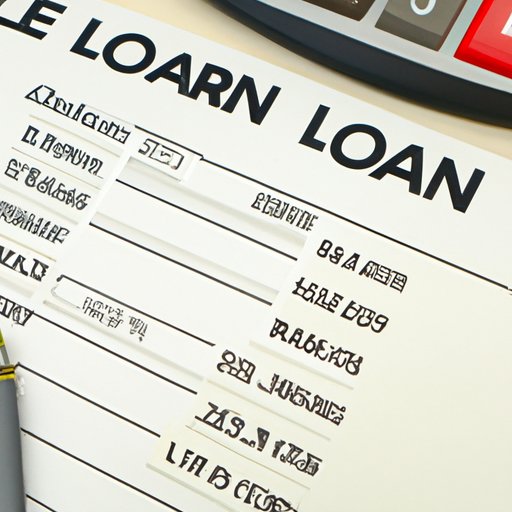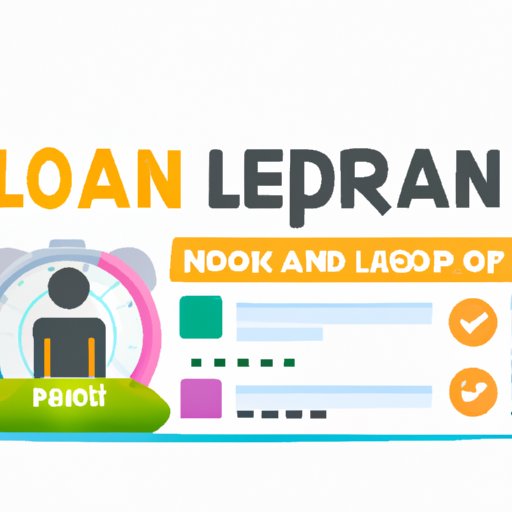Introduction
A personal loan is a type of loan that is designed to help individuals finance their personal needs. It can be used for a variety of purposes, including home renovations, medical bills, car repairs, or other purchases. When it comes to personal loans, one of the most important questions is how much you can get. This article will explore the different factors that affect your maximum loan amount, and provide tips on how to identify the best loan options for your needs.
Calculating Your Maximum Loan Amount: What Factors to Consider
When it comes to determining how much you can borrow with a personal loan, there are several factors to consider. These include your credit score, income and expenses, and debt-to-income ratio.
Credit Score
Your credit score is one of the most important factors that lenders consider when determining your maximum loan amount. Generally speaking, the higher your credit score, the more money you can borrow. If your credit score is lower than average, you may be limited to smaller loan amounts.
Income and Expenses
Your income and expenses also play a role in determining your maximum loan amount. Lenders typically look at your total monthly income, as well as any existing debts you may have. They will use this information to calculate your debt-to-income ratio, which is an indication of how much of your income is going towards paying off debt.
Debt-to-Income Ratio
Your debt-to-income ratio is an important indicator of your ability to repay a loan. Generally speaking, lenders prefer a debt-to-income ratio of 36% or less. If your ratio is higher than this, you may be limited to smaller loan amounts.
How Much Can You Borrow with a Personal Loan?
The amount you can borrow with a personal loan depends on several factors, including the type of loan, your credit score, and your income and expenses. Different types of personal loans have different limits, so it’s important to understand the differences before applying for a loan.
Different Types of Personal Loans
There are several different types of personal loans available, including secured loans, unsecured loans, credit card loans, and online loans. Each type of loan has its own set of limits, so it’s important to research your options before deciding which type of loan is right for you.
Limits on Personal Loans
Most personal loans have a minimum loan amount of $1,000 and a maximum loan amount of $50,000. However, some lenders may offer higher loan amounts depending on your credit score and other factors. It’s important to shop around and compare different lenders to find the best loan terms for your needs.
Understanding the Impact of Credit Score on Personal Loan Amounts
Your credit score is one of the most important factors that lenders consider when determining your maximum loan amount. Generally speaking, the higher your credit score, the more money you can borrow. Conversely, if your credit score is lower than average, you may be limited to smaller loan amounts.
Good vs. Bad Credit Scores
A good credit score is generally considered to be above 700. With a good credit score, you are likely to receive better interest rates and higher loan amounts. On the other hand, if your credit score is below 600, you may not qualify for some personal loans, and the ones you do qualify for may have higher interest rates and lower loan amounts.
How Your Credit Score Affects Your Maximum Loan Amount
Generally speaking, the higher your credit score, the higher your maximum loan amount. For example, if you have a credit score of 750 or above, you may be able to borrow up to $50,000 with a personal loan. On the other hand, if your credit score is below 600, you may only be able to borrow up to $25,000.

Exploring Different Types of Personal Loans and Their Limits
Different types of personal loans have different limits, so it’s important to understand the differences before applying for a loan. Here is a brief overview of the different types of personal loans and their limits.
Secured vs. Unsecured Loans
Secured loans require collateral, such as a house or car, and generally have higher loan limits than unsecured loans. Unsecured loans do not require collateral and typically have lower loan limits.
Credit Card Loans
Credit card loans are typically limited to the amount of available credit on the card. Most credit cards have a limit of $5,000 to $10,000, but some may offer higher limits.
Online Lenders
Many online lenders offer personal loans with no minimum or maximum loan limits. However, these loans usually have higher interest rates than traditional loans.

Estimating Your Personal Loan Amount Based on Income and Expenses
In addition to your credit score, lenders also consider your income and expenses when determining your maximum loan amount. Here are some tips on estimating your personal loan amount based on your income and expenses.
Determining Your Budget
The first step in estimating your personal loan amount is to determine your budget. To do this, you should calculate your total monthly income and subtract your monthly expenses. The amount left over is the amount you can comfortably afford to pay back each month.
Taking into Account Other Debts
It’s also important to take into account any other debts you may have, such as student loans or car payments. This will help you determine how much you can realistically afford to pay back each month.

Identifying the Best Options for Getting the Most from Your Personal Loan
Once you’ve determined your maximum loan amount, it’s time to start shopping around for the best loan options. Here are some tips on how to identify the best loan options for your needs.
Comparing Different Lenders
When shopping for a personal loan, it’s important to compare different lenders to find the best rates and terms. Make sure to read the fine print and understand all the fees and charges associated with the loan.
Shopping Around for the Best Rates
It’s also important to shop around for the best rates. Compare interest rates, loan terms, and other fees to make sure you’re getting the best deal possible.
Determining the Right Amount for Your Personal Loan Needs
Once you’ve identified the best loan options for your needs, it’s important to determine the right amount for your loan. Here are some things to consider when deciding on the right loan amount for your needs.
Understanding Your Financial Goals
Before taking out a loan, it’s important to understand your financial goals. Are you looking to consolidate debt, buy a car, or fund a home improvement project? Knowing your goals will help you determine the right loan amount for your needs.
Evaluating Your Ability to Repay the Loan
It’s also important to evaluate your ability to repay the loan. Make sure you can comfortably afford the monthly payments and that you have enough money left over for other expenses.
Conclusion
In conclusion, it’s important to understand the different factors that affect your maximum loan amount, such as your credit score, income and expenses, and debt-to-income ratio. Different types of personal loans have different limits, so it’s important to understand the differences before applying for a loan. Additionally, it’s important to identify the best loan options for your needs by comparing different lenders and shopping around for the best rates. Finally, it’s important to determine the right loan amount for your needs by understanding your financial goals and evaluating your ability to repay the loan.
(Note: Is this article not meeting your expectations? Do you have knowledge or insights to share? Unlock new opportunities and expand your reach by joining our authors team. Click Registration to join us and share your expertise with our readers.)
